Remaining Useful Life Prediction of the Concrete Piston Based on Probability Statistics and Data Driven
Abstract
:1. Preface
2. Data Overview
2.1. Data Source
2.2. Data Description
2.3. Data Preprocessing
3. Model Building
3.1. Model Construction
3.2. The Average Useful Life of the Concrete Piston
3.3. The Life Coefficient of the Concrete Piston
3.3.1. MLR
3.3.2. SVR
3.3.3. RFR
4. Result Analysis
5. Dependence of RUL Prediction on Working Time
6. Conclusions
Author Contributions
Funding
Conflicts of Interest
References
- Doyen, L.; Gaudoin, O. Modelling and assessment of aging and efficiency of corrective and planned preventive maintenance. IEEE Trans. Reliab. 2011, 60, 759–769. [Google Scholar] [CrossRef]
- Heng, A.; Zhang, S.; Tan, A.C.; Mathew, J. Rotating machinery prognostics: State of the art, challenges and opportunities. Mech. Syst. Signal Process. 2009, 23, 724–739. [Google Scholar] [CrossRef]
- Tang, D.; Makis, V.; Jafari, L.; Yu, J. Optimal maintenance policy and residual life estimation for a slowly degrading system subject to condition monitoring. Reliab. Eng. Syst. Saf. 2015, 134, 198–207. [Google Scholar] [CrossRef]
- Lei, Y.; Li, N.; Guo, L.; Li, N.; Yan, T.; Lin, J. Machinery health prognostics: A systematic review from data acquisition to RUL prediction. Mech. Syst. Signal Process. 2018, 104, 799–834. [Google Scholar] [CrossRef]
- Lee, J.; Wu, F.; Zhao, W.; Ghaffari, M.; Liao, L.; Siegel, D. Prognostics and health management design for rotary machinery systems—Reviews, methodology and applications. Mech. Syst. Signal Process. 2014, 42, 314–334. [Google Scholar] [CrossRef]
- Vachtsevanos, G.; Lewis, F.; Roemer, M.; Hess, A.; Wu, B. Intelligent Fault Diagnosis and Prognosis for Engineering Systems; Wiley: Hoboken, NJ, USA, 2007. [Google Scholar]
- Liao, L.; Kottig, F. Review of Hybrid Prognostics Approaches for Remaining Useful Life Prediction of Engineered Systems, and an Application to Battery Life Prediction. IEEE Trans. Reliab. 2014, 63, 191–207. [Google Scholar] [CrossRef]
- Si, X.; Wang, W.; Hu, C.; Zhou, D. Remaining useful life estimation: A review on the statistical data driven approaches. Eur. J. Oper. Res. 2011, 213, 1–14. [Google Scholar] [CrossRef]
- Leser, P.; Hochhalter, J.; Newman, J.; Leser, W.; Warner, J.; Wawrzynek, P.; Yuan, F. Probabilistic fatigue damage prognosis using surrogate models trained via three-dimensional finite element analysis. Struct. Health Monit. 2017, 16, 291–308. [Google Scholar] [CrossRef] [Green Version]
- Habib, S.; Yousuf, W.; Mairaj, T.; Khalid, S. Fatigue Crack Growth prediction on A310 aircraft wing using static analysis. In Proceedings of the International Bhurban Conference on Applied Sciences and Technology (IBCAST), Islamabad, Pakistan, 10–14 January 2017. [Google Scholar]
- Chen, J.; Browne, M.; Taylor, M.; Gregson, P. Application of an interface failure model to predict fatigue crack growth in an implanted metallic femoral stem. Comput. Methods Programs Biomed. 2004, 73, 249–256. [Google Scholar] [CrossRef]
- Wang, Y.; Chen, Z.; Zhang, Y.; Li, X.; Li, Z. Remaining useful life prediction of rolling bearings based on the three-parameter Weibull distribution proportional hazards model. Ins.-Non-Des. Test Con. Monit. 2020, 62, 710–718. [Google Scholar]
- Pan, Q.; Xie, W.; He, S. Assessment on Remanufacturability of the Placer Jib of Concrete Pump Truck Based on Reliability Model. Mach. Des. Res. 2015, 109–113. [Google Scholar]
- Xu, W.; Hu, W.; Sun, P. Research on Equipment Reliability Prediction Based on Two-parameter Weibull Distribution. Chin. J. Constr. Mach. 2013, 11, 112–116. [Google Scholar]
- Rong, T.; Meng, B. Remaining Life Evaluation of Boom System of the concrete pump truck Based on Weibull Distribution. Mech. Eng. Tech. 2018, 7, 443–450. [Google Scholar] [CrossRef]
- Ren, L.; Cui, J.; Sun, Y. Multi-bearing remaining useful life collaborative prediction: A deep learning approach. J. Manuf. Syst. 2017, 248–256. [Google Scholar] [CrossRef]
- Liu, Z.; Zuo, M.; Qin, Y. Remaining useful life prediction of rolling element bearings based on health state assessment. Proc. Inst. Mech. Eng. Part C J. Mech. Eng. Sci. 2016, 230, 314–330. [Google Scholar] [CrossRef] [Green Version]
- Zio, E.; Peloni, G. Particle filtering prognostic estimation of the remaining useful life of nonlinear components. Reliab. Eng. Syst. Saf. 2011, 96, 403–409. [Google Scholar] [CrossRef]
- Sun, C.; Zhang, Z.; He, Z. Research on bearing life prediction based on support vector machine and its application. J. Phys. Conf. Ser. 2011, 305, 012028. [Google Scholar] [CrossRef]
- Maio, F.; Tsui, K.; Zio, E. Combining relevance vector machines and exponential regression for bearing residual life estimation. Mech. Syst. Signal Proc. 2012, 31, 405–427. [Google Scholar] [CrossRef]
- Deutsch, J.; He, D. Using Deep Learning-Based Approach to Predict Remaining Useful Life of Rotating Components. IEEE Trans. Syst. Man Cybern. Syst. 2017, 48, 11–20. [Google Scholar] [CrossRef]
- Djeziri, M.A.; Benmoussa, S.; Mouchaweh, M.S.; Lughofer, E. Fault diagnosis and prognosis based on physical knowledge and reliability data: Application to MOS Field-Effect Transistor. Microelectron. Reliab. 2020, 110. [Google Scholar] [CrossRef]
- Xu, J.; Wang, Y.; Xu, L. PHM-Oriented Integrated Fusion Prognostics for Aircraft Engines Based on Sensor Data. IEEE Sens. J. 2014, 14, 1124–1132. [Google Scholar] [CrossRef]
- Okoh, C.; Roy, R.; Mehnen, J.; Redding, L. Overview of Remaining Useful Life Prediction Techniques in Through-life Engineering Services. Proc. CIRP 2014, 16, 158–163. [Google Scholar] [CrossRef] [Green Version]
- Ling, D.; He, L.; Xu, H. Fatigue Residual Life Reliability Prediction Method Based on Weibull Distribution. J. Mach. Desi. 2011, 28, 50–54. [Google Scholar]
- Jchabd, E.; Yctb, D.; Pywab, E. Predictive modeling of blood pressure during hemodialysis: A comparison of linear model, random forest, support vector regression, XGBoost, LASSO regression and ensemble method. Comput. Methods Programs Biomed. 2020, 195, 105536. [Google Scholar]

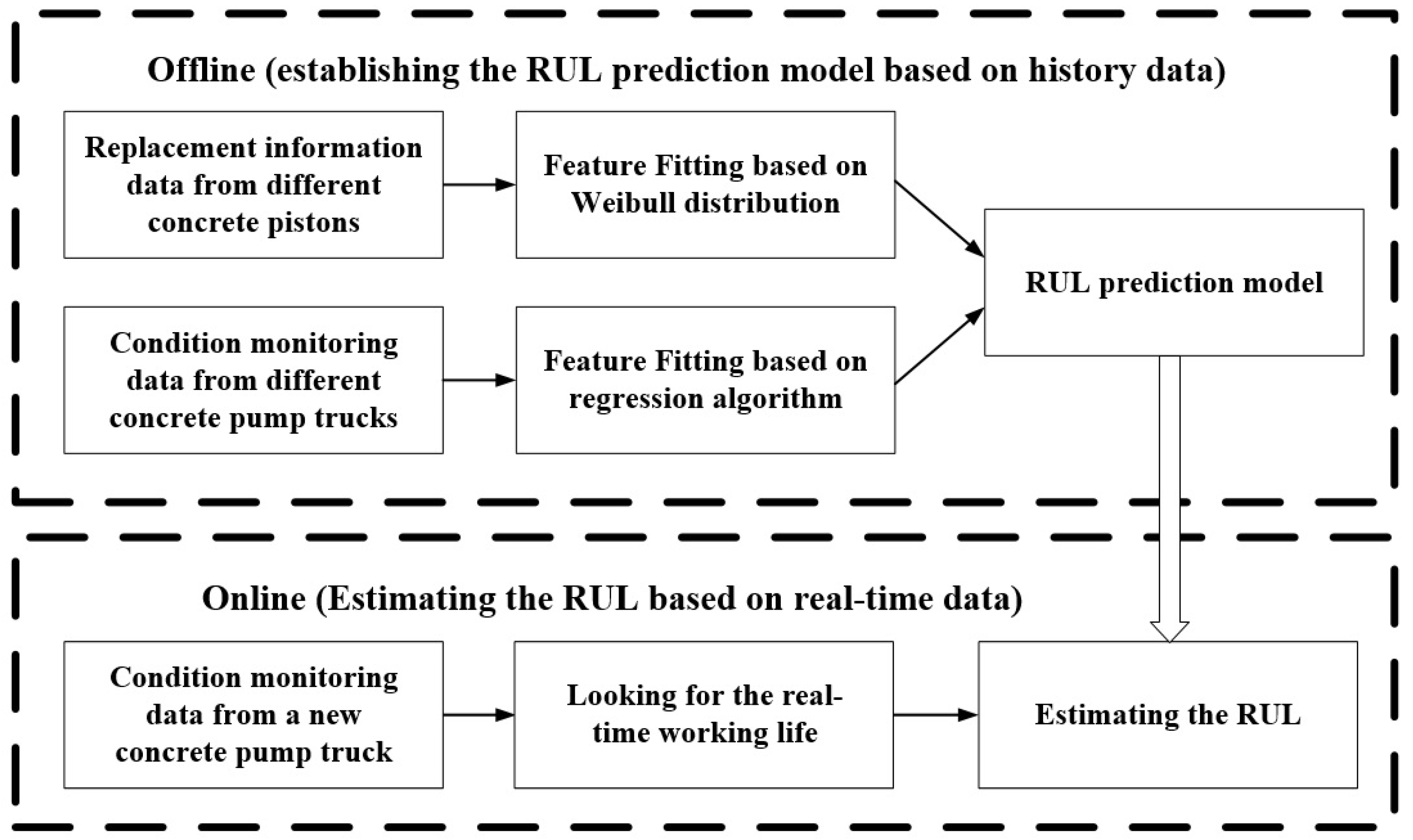

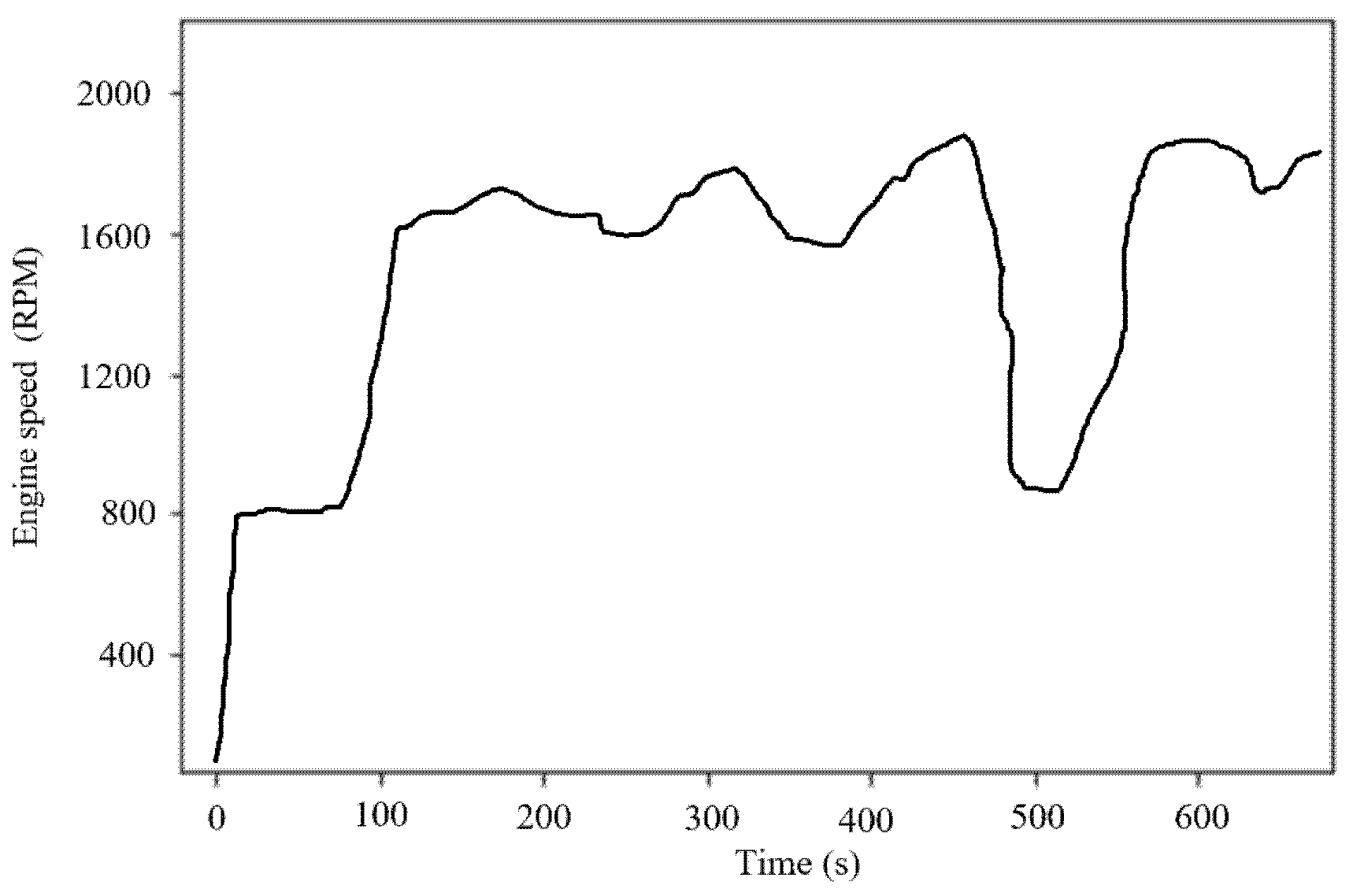
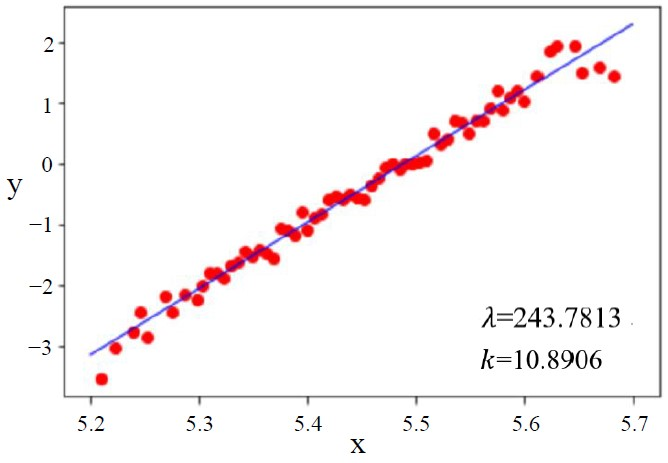
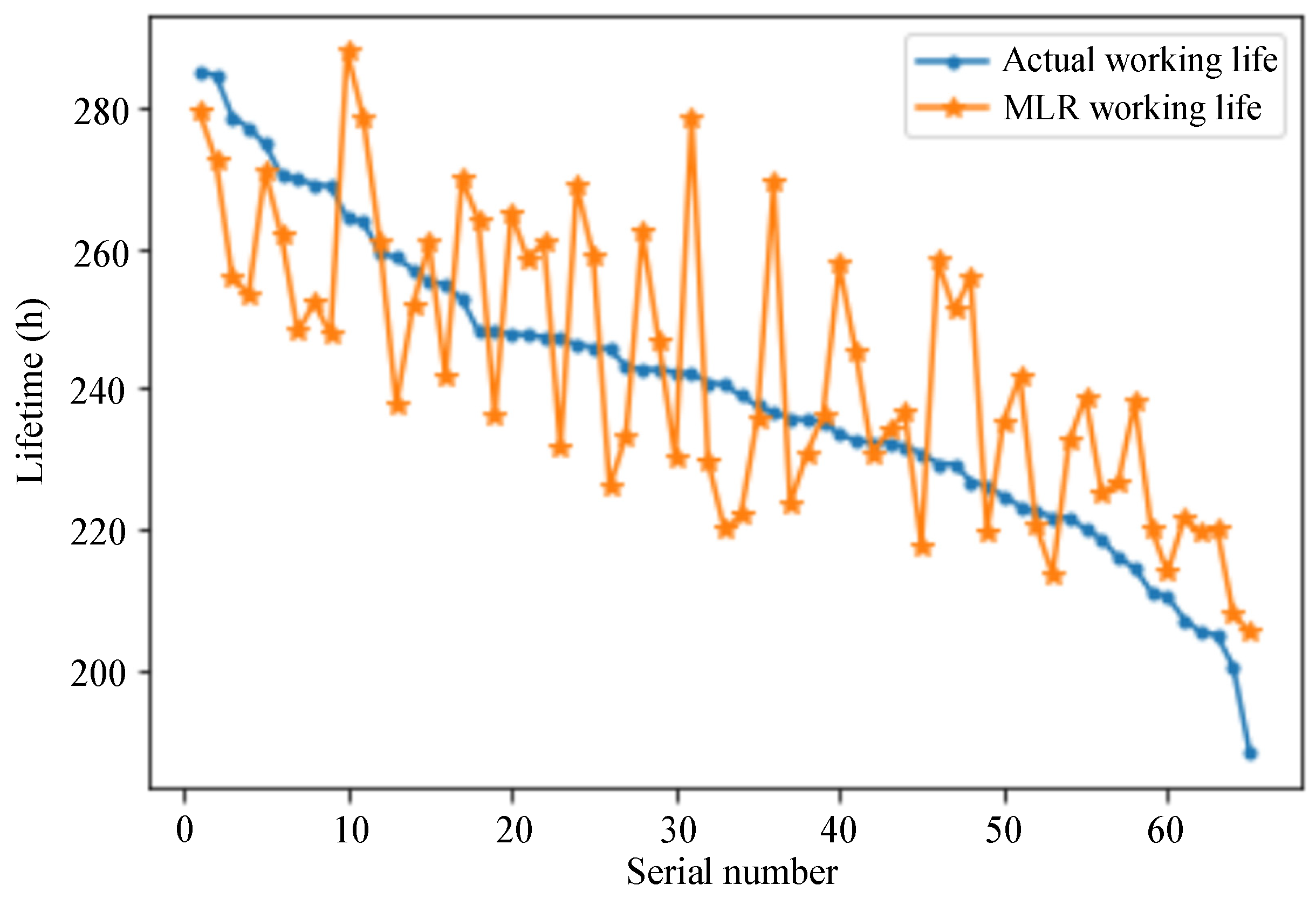
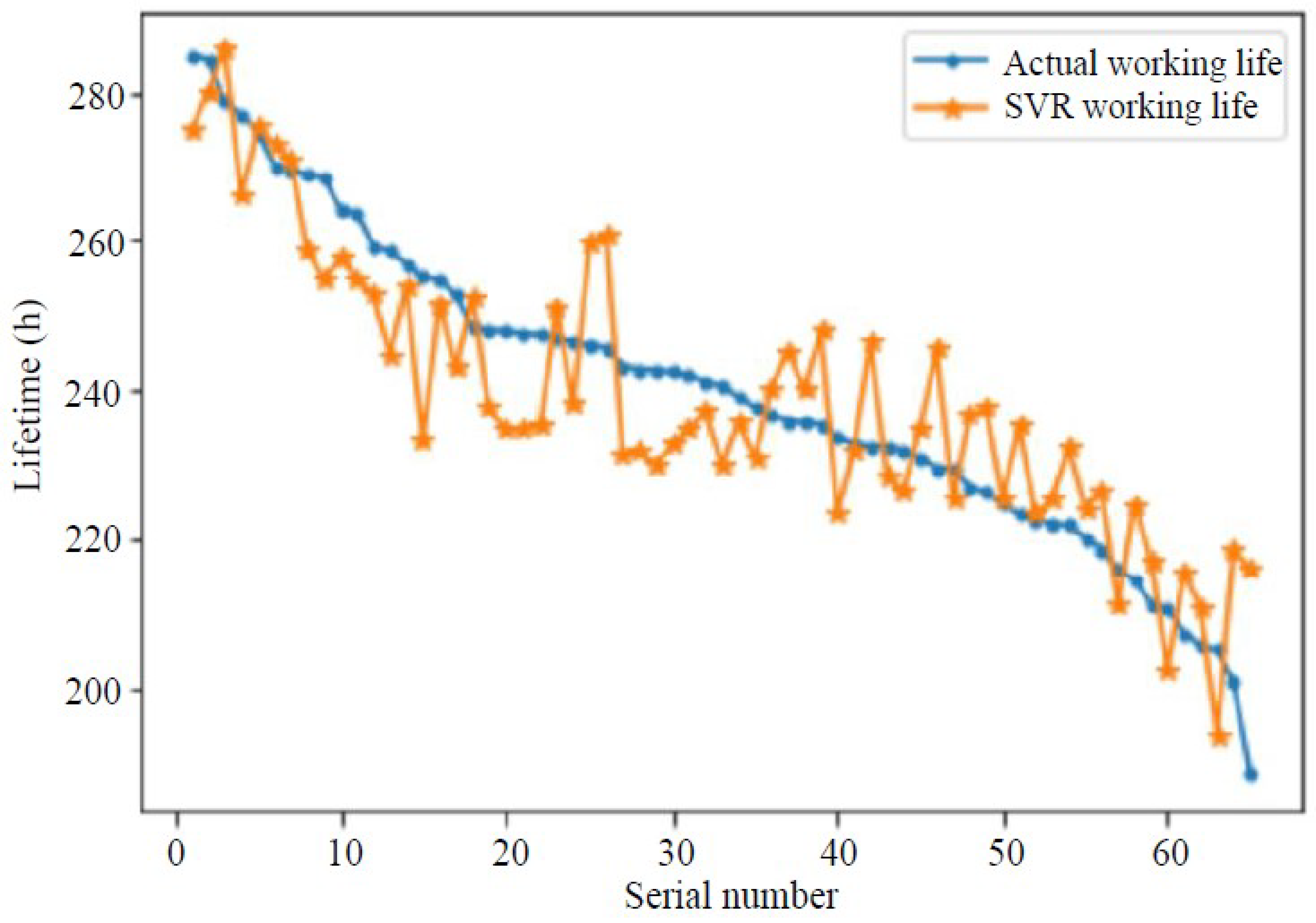
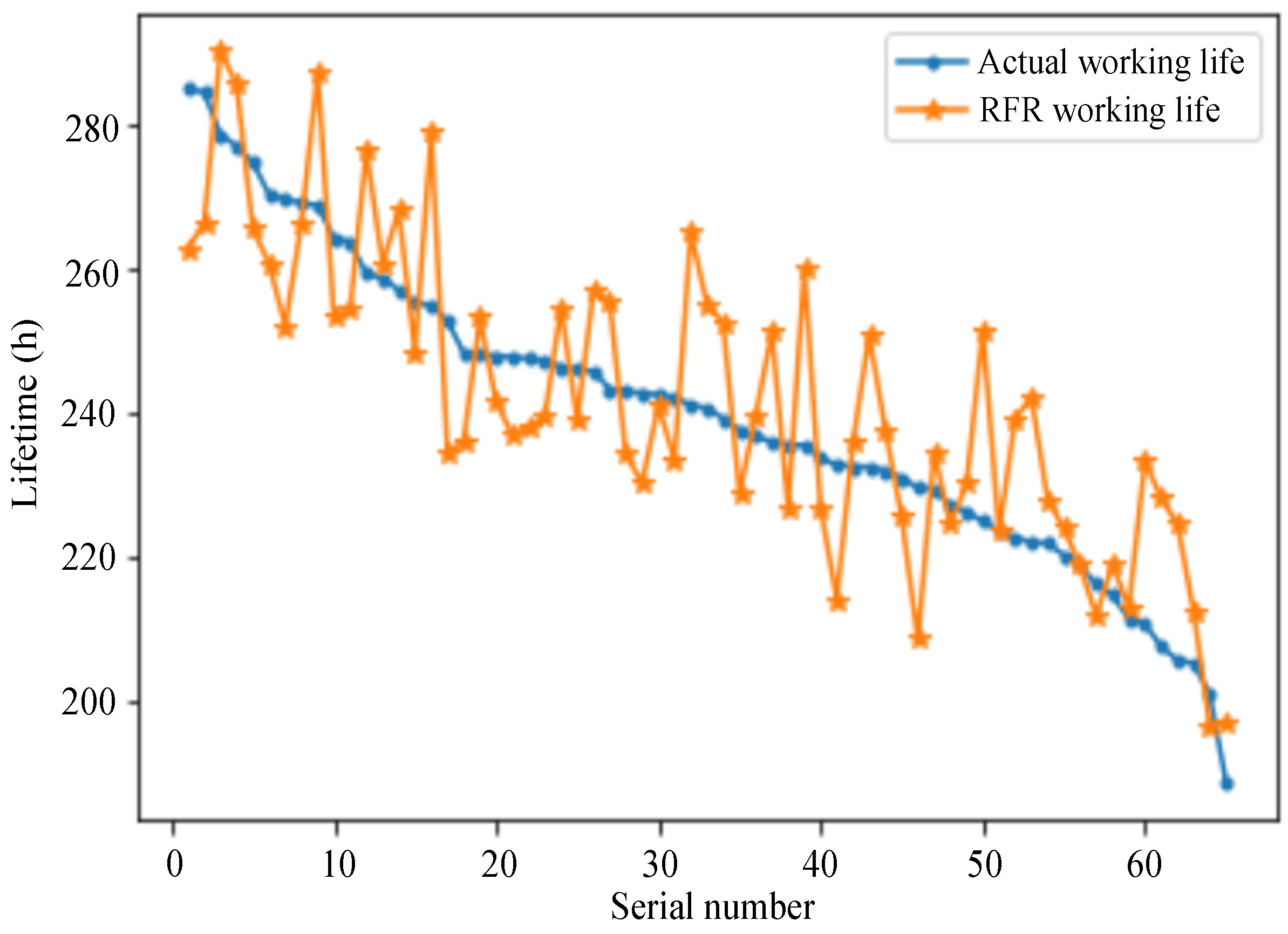

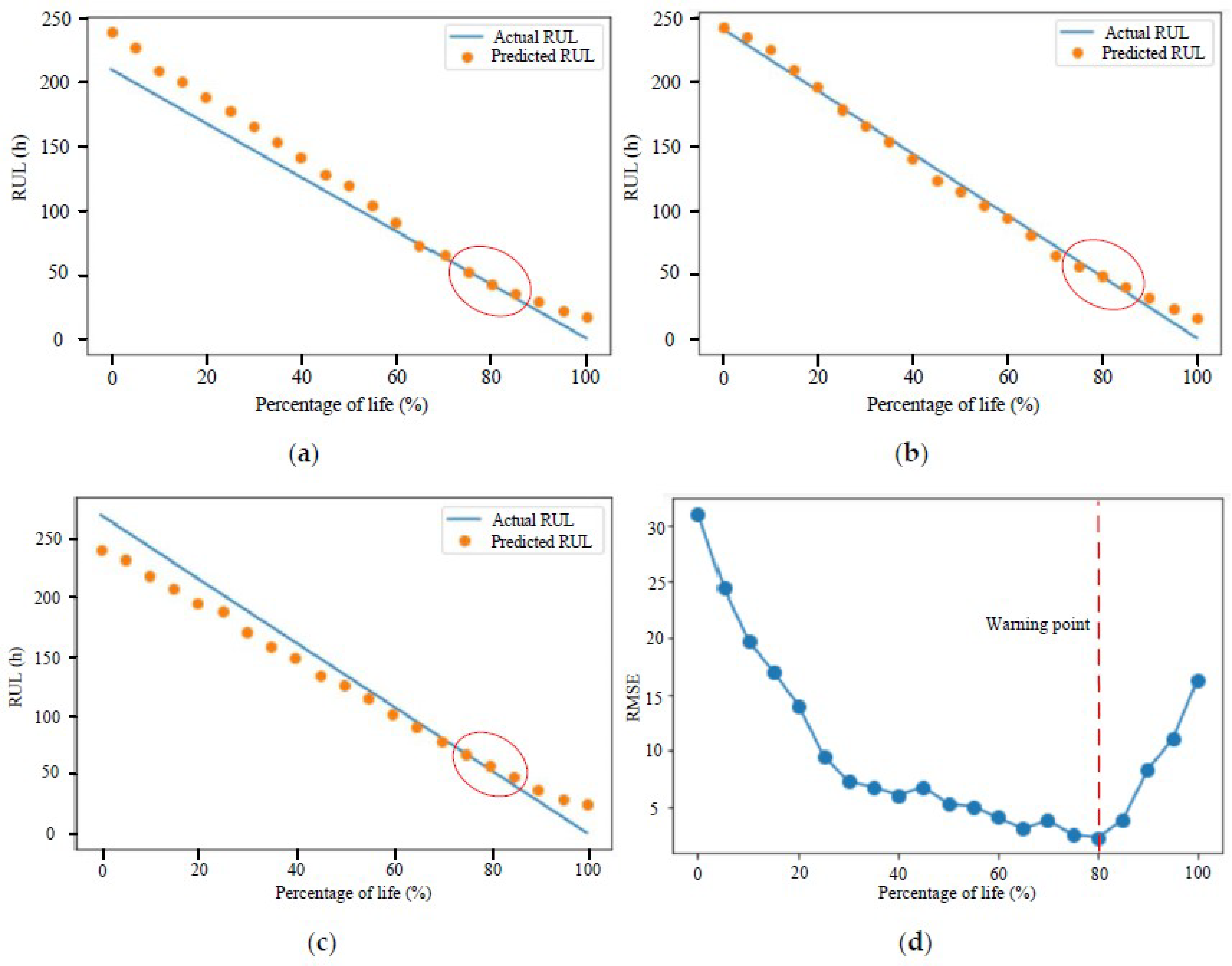
| Name | Data Type | Unit | Scope | Meaning |
|---|---|---|---|---|
| Engine Speed | integral | RPM | 0~2000 | The speed of pump truck engine |
| System Pressure | integral | MPa | 0~32 | pump hydraulic pressure of pumping system |
| Pumping Capacity | integral | % | 0~100 | The percentage of pump truck in its maximum value |
| Reversing Frequency | integral | times/minute | 0~30 | Pump cylinder reversing times per minute |
| Cumulative Working Time | floating | hour | 0 | Cumulative working time of pump truck |
| Name | Unit | Normal Range | High-Load Working State |
|---|---|---|---|
| Engine Speed | RPM | 0~2000 | ≥1100 |
| System Pressure | MPa | 0~32 | ≥20 |
| Pumping Capacity | % | 0~100 | ≥40 |
| Reversing Frequency | Times/minute | 0~30 | ≥10 |
| Number | A | B | C | D | M0 | α |
|---|---|---|---|---|---|---|
| 1 | 0.5327 | 0.4649 | 0.2237 | 0.2131 | 275.7432 | 1.1507 |
| 2 | 0.4834 | 0.5586 | 0.2634 | 0.2056 | 258.7615 | 1.0779 |
| 3 | 0.4930 | 0.6394 | 0.2414 | 0.2527 | 232.4608 | 0.9701 |
| 4 | 0.4986 | 0.5002 | 0.1362 | 0.3006 | 257.3100 | 1.0738 |
| 5 | 0.6929 | 0.7160 | 0.3275 | 0.2343 | 269.2673 | 1.1237 |
| 6 | 0.5578 | 0.4718 | 0.3005 | 0.2156 | 236.1271 | 0.9854 |
| 7 | 0.4119 | 0.5886 | 0.2571 | 0.2779 | 263.5402 | 1.0998 |
| 8 | 0.4184 | 0.5829 | 0.2636 | 0.3029 | 259.3468 | 1.0823 |
| 9 | 0.4356 | 0.3802 | 0.2173 | 0.2318 | 264.6904 | 1.1046 |
| 10 | 0.7991 | 0.7307 | 0.3154 | 0.2297 | 229.6332 | 0.9583 |
| 11 | 0.6120 | 0.4617 | 0.1180 | 0.1447 | 256.2317 | 1.0693 |
| 12 | 0.6313 | 0.5106 | 0.3080 | 0.2707 | 254.0271 | 1.0601 |
| 13 | 0.4727 | 0.5465 | 0.1920 | 0.1924 | 264.5467 | 1.1040 |
| 14 | 0.3900 | 0.4855 | 0.2124 | 0.2814 | 261.2638 | 1.0903 |
| 15 | 0.5690 | 0.4688 | 0.3515 | 0.1846 | 258.9155 | 1.0805 |
| 16 | 0.3960 | 0.4253 | 0.1909 | 0.2327 | 265.2655 | 1.1070 |
| 17 | 0.6260 | 0.5851 | 0.1903 | 0.2584 | 220.7671 | 0.9213 |
| 18 | 0.4700 | 0.5367 | 0.1802 | 0.2610 | 264.2112 | 1.1026 |
| 19 | 0.5186 | 0.4900 | 0.3221 | 0.2101 | 240.6081 | 1.0041 |
| 20 | 0.3908 | 0.4339 | 0.1765 | 0.2387 | 256.1118 | 1.0688 |
| 21 | 0.4351 | 0.4570 | 0.1445 | 0.1752 | 253.8594 | 1.0594 |
| 22 | 0.3740 | 0.7600 | 0.4246 | 0.3216 | 214.8962 | 0.8968 |
| 23 | 0.5351 | 0.6035 | 0.3396 | 0.2556 | 233.5870 | 0.9748 |
| 24 | 0.4302 | 0.5646 | 0.2063 | 0.2923 | 236.6303 | 0.9875 |
| 25 | 0.5283 | 0.4452 | 0.2472 | 0.2426 | 244.3702 | 1.0198 |
| 26 | 0.6663 | 0.6448 | 0.2218 | 0.2453 | 228.8664 | 0.9551 |
| 27 | 0.5727 | 0.7697 | 0.3411 | 0.2537 | 219.0657 | 0.9142 |
| 28 | 0.6345 | 0.5055 | 0.2151 | 0.2957 | 232.2691 | 0.9693 |
| 29 | 0.5842 | 0.4344 | 0.2726 | 0.2262 | 253.6437 | 1.0585 |
| 30 | 0.6911 | 0.4715 | 0.2746 | 0.2917 | 244.1066 | 1.0187 |
| 31 | 0.5448 | 0.6426 | 0.2909 | 0.3201 | 233.3714 | 0.9739 |
| 32 | 0.3929 | 0.5887 | 0.2085 | 0.2582 | 238.4754 | 0.9952 |
| 33 | 0.5501 | 0.6243 | 0.1731 | 0.1468 | 247.1259 | 1.0313 |
| 34 | 0.5889 | 0.6195 | 0.2080 | 0.2483 | 252.7092 | 1.0546 |
| 35 | 0.7093 | 0.3554 | 0.3357 | 0.2742 | 247.8687 | 1.0344 |
| 36 | 0.3942 | 0.5236 | 0.2500 | 0.2306 | 253.4520 | 1.0577 |
| 37 | 0.7755 | 0.6721 | 0.3851 | 0.3027 | 237.2293 | 0.9900 |
| 38 | 0.4760 | 0.5225 | 0.1709 | 0.1920 | 252.3737 | 1.0532 |
| 39 | 0.5700 | 0.5270 | 0.3312 | 0.3010 | 239.8652 | 1.0010 |
| 40 | 0.7545 | 0.7045 | 0.3351 | 0.2761 | 228.3153 | 0.9528 |
| 41 | 0.5298 | 0.6320 | 0.3479 | 0.2816 | 224.8167 | 0.9382 |
| 42 | 0.5825 | 0.5987 | 0.2093 | 0.1327 | 227.9079 | 0.9511 |
| 43 | 0.5853 | 0.4876 | 0.1834 | 0.2694 | 217.8916 | 0.9093 |
| 44 | 0.5451 | 0.4701 | 0.3063 | 0.2326 | 252.9009 | 1.0554 |
| 45 | 0.4657 | 0.5438 | 0.2912 | 0.3321 | 245.7600 | 1.0256 |
| 46 | 0.5847 | 0.4798 | 0.3163 | 0.2012 | 235.1206 | 0.9812 |
| 47 | 0.7705 | 0.5957 | 0.2533 | 0.2740 | 230.4479 | 0.9617 |
| 48 | 0.6602 | 0.6436 | 0.3349 | 0.2553 | 232.0774 | 0.9685 |
| 49 | 0.5163 | 0.4518 | 0.2932 | 0.2523 | 280.4338 | 1.1703 |
| 50 | 0.4919 | 0.4107 | 0.1371 | 0.1977 | 248.3719 | 1.0365 |
| 51 | 0.5353 | 0.7071 | 0.3681 | 0.3211 | 213.4345 | 0.8907 |
| 52 | 0.6934 | 0.6488 | 0.3370 | 0.2824 | 233.9944 | 0.9765 |
| 53 | 0.6387 | 0.6471 | 0.3739 | 0.2274 | 241.2790 | 1.0069 |
| 54 | 0.4278 | 0.4885 | 0.1921 | 0.2458 | 246.6946 | 1.0295 |
| 55 | 0.6932 | 0.4207 | 0.2761 | 0.2872 | 242.2136 | 1.0108 |
| 56 | 0.5113 | 0.5023 | 0.1883 | 0.2215 | 253.3322 | 1.0572 |
| 57 | 0.5476 | 0.3089 | 0.1933 | 0.2920 | 252.1820 | 1.0524 |
| 58 | 0.6081 | 0.5186 | 0.3280 | 0.3104 | 231.7419 | 0.9671 |
| 59 | 0.3961 | 0.5079 | 0.2603 | 0.2196 | 260.6168 | 1.0876 |
| 60 | 0.3500 | 0.4500 | 0.1602 | 0.1790 | 263.3725 | 1.0991 |
| 61 | 0.5502 | 0.4101 | 0.3263 | 0.3634 | 249.2585 | 1.0402 |
| 62 | 0.5534 | 0.7115 | 0.2740 | 0.3103 | 230.5678 | 0.9622 |
| 63 | 0.4785 | 0.5300 | 0.2183 | 0.1731 | 260.3293 | 1.0864 |
| 64 | 0.5698 | 0.6483 | 0.2974 | 0.2842 | 235.8635 | 0.9843 |
| 65 | 0.3904 | 0.6349 | 0.3511 | 0.2974 | 233.3953 | 0.9740 |
| 66 | 0.7074 | 0.6328 | 0.2938 | 0.2446 | 231.8617 | 0.9676 |
| 67 | 0.5023 | 0.5521 | 0.3031 | 0.2701 | 238.1160 | 0.9937 |
| 68 | 0.6151 | 0.5705 | 0.2962 | 0.2476 | 234.2580 | 0.9776 |
| 69 | 0.6402 | 0.6849 | 0.3190 | 0.3735 | 235.0248 | 0.9808 |
| 70 | 0.5425 | 0.4229 | 0.3202 | 0.2349 | 259.1311 | 1.0814 |
| 71 | 0.3712 | 0.2922 | 0.2286 | 0.2336 | 247.1498 | 1.0314 |
| 72 | 0.6459 | 0.6576 | 0.2489 | 0.3010 | 231.8378 | 0.9675 |
| 73 | 0.4173 | 0.5811 | 0.4002 | 0.2432 | 241.3988 | 1.0074 |
| 74 | 0.5381 | 0.4812 | 0.2163 | 0.2784 | 246.9581 | 1.0306 |
| 75 | 0.5551 | 0.5284 | 0.3487 | 0.2546 | 242.4053 | 1.0116 |
| 76 | 0.5160 | 0.5578 | 0.3080 | 0.2523 | 242.2375 | 1.0109 |
| 77 | 0.5938 | 0.6039 | 0.3585 | 0.3144 | 234.3299 | 0.9779 |
| 78 | 0.6394 | 0.7066 | 0.3317 | 0.3065 | 225.4877 | 0.9410 |
| 79 | 0.3929 | 0.5261 | 0.2584 | 0.1987 | 249.4263 | 1.0409 |
| 80 | 0.3853 | 0.4664 | 0.1966 | 0.1815 | 254.3386 | 1.0614 |
| 81 | 0.5490 | 0.4925 | 0.1901 | 0.2395 | 255.7284 | 1.0672 |
| 82 | 0.4072 | 0.5081 | 0.1832 | 0.2050 | 268.5244 | 1.1206 |
| 83 | 0.4886 | 0.3629 | 0.2008 | 0.1686 | 271.1124 | 1.1314 |
| 84 | 0.7053 | 0.5604 | 0.3034 | 0.3427 | 216.3580 | 0.9029 |
| 85 | 0.4791 | 0.3072 | 0.2206 | 0.1546 | 253.4280 | 1.0576 |
| 86 | 0.5439 | 0.4260 | 0.1583 | 0.2440 | 250.6963 | 1.0462 |
| 87 | 0.4787 | 0.4619 | 0.2312 | 0.2319 | 270.0101 | 1.1268 |
| 88 | 0.5503 | 0.6096 | 0.2473 | 0.2190 | 250.5765 | 1.0457 |
| 89 | 0.6039 | 0.4221 | 0.2556 | 0.3442 | 234.9289 | 0.9804 |
| 90 | 0.5919 | 0.7085 | 0.2408 | 0.3349 | 214.0815 | 0.8934 |
| 91 | 0.4955 | 0.3821 | 0.3156 | 0.2506 | 248.3240 | 1.0363 |
| 92 | 0.5745 | 0.4788 | 0.2822 | 0.3193 | 231.8617 | 0.9676 |
| 93 | 0.6116 | 0.6443 | 0.2551 | 0.3027 | 234.6654 | 0.9793 |
| 94 | 0.6295 | 0.4652 | 0.3162 | 0.4058 | 225.7513 | 0.9421 |
| 95 | 0.5539 | 0.5181 | 0.2986 | 0.2226 | 247.7010 | 1.0337 |
| 96 | 0.6030 | 0.5657 | 0.3448 | 0.2144 | 237.2773 | 0.9902 |
| 97 | 0.4644 | 0.3807 | 0.1791 | 0.1555 | 272.2147 | 1.1360 |
| 98 | 0.6541 | 0.5545 | 0.4018 | 0.2551 | 240.7039 | 1.0045 |
| 99 | 0.4365 | 0.5885 | 0.3102 | 0.3304 | 242.4771 | 1.0119 |
| 100 | 0.6328 | 0.6943 | 0.3283 | 0.2597 | 234.9529 | 0.9805 |
| 101 | 0.5775 | 0.6414 | 0.2589 | 0.2481 | 225.5356 | 0.9412 |
| 102 | 0.4527 | 0.5211 | 0.2768 | 0.2113 | 240.4164 | 1.0033 |
| 103 | 0.5238 | 0.7210 | 0.3026 | 0.2791 | 228.6987 | 0.9544 |
| 104 | 0.6701 | 0.8097 | 0.2931 | 0.2319 | 211.7092 | 0.8835 |
| 105 | 0.5494 | 0.5042 | 0.1770 | 0.3102 | 243.0283 | 1.0142 |
| 106 | 0.5987 | 0.6512 | 0.3512 | 0.3089 | 225.9669 | 0.9430 |
| 107 | 0.5480 | 0.6019 | 0.3675 | 0.3097 | 236.6782 | 0.9877 |
| 108 | 0.6178 | 0.5802 | 0.3709 | 0.2382 | 232.1014 | 0.9686 |
| 109 | 0.5233 | 0.4629 | 0.2508 | 0.2647 | 264.5227 | 1.1039 |
| 110 | 0.5416 | 0.6134 | 0.2541 | 0.3603 | 229.9927 | 0.9598 |
| 111 | 0.6049 | 0.7044 | 0.2866 | 0.2677 | 233.7787 | 0.9756 |
| 112 | 0.7767 | 0.7459 | 0.3312 | 0.2980 | 224.0499 | 0.9350 |
| 113 | 0.7424 | 0.7940 | 0.2892 | 0.3641 | 229.4655 | 0.9576 |
| 114 | 0.4251 | 0.3137 | 0.1863 | 0.2582 | 255.2013 | 1.0650 |
| 115 | 0.4677 | 0.4836 | 0.2420 | 0.1943 | 247.6051 | 1.0333 |
| 116 | 0.4719 | 0.5506 | 0.1208 | 0.2607 | 249.9535 | 1.0431 |
| 117 | 0.7987 | 0.5091 | 0.2065 | 0.2828 | 244.6338 | 1.0209 |
| 118 | 0.6100 | 0.5015 | 0.3600 | 0.3276 | 241.5426 | 1.0080 |
| 119 | 0.6669 | 0.6183 | 0.2327 | 0.2860 | 238.7390 | 0.9963 |
| 120 | 0.5130 | 0.5522 | 0.1823 | 0.1880 | 256.2796 | 1.0695 |
| 121 | 0.5116 | 0.4400 | 0.2182 | 0.2465 | 265.7688 | 1.1091 |
| 122 | 0.5734 | 0.4599 | 0.2170 | 0.2026 | 239.1463 | 0.9980 |
| 123 | 0.5844 | 0.4862 | 0.2918 | 0.2739 | 213.8898 | 0.8926 |
| 124 | 0.6483 | 0.5492 | 0.3449 | 0.3031 | 233.2516 | 0.9734 |
| 125 | 0.3913 | 0.3401 | 0.1683 | 0.1353 | 262.7974 | 1.0967 |
| 126 | 0.5527 | 0.6217 | 0.2720 | 0.2031 | 229.3457 | 0.9571 |
| 127 | 0.5998 | 0.5637 | 0.2898 | 0.2458 | 236.9178 | 0.9887 |
| 128 | 0.5878 | 0.4996 | 0.3996 | 0.3000 | 272.6939 | 1.1380 |
| 129 | 0.5611 | 0.5380 | 0.2617 | 0.2755 | 241.4468 | 1.0076 |
| 130 | 0.4203 | 0.4602 | 0.2533 | 0.2163 | 288.0779 | 1.2022 |
| 131 | 0.5129 | 0.5617 | 0.3285 | 0.2422 | 235.8395 | 0.9842 |
| 132 | 0.4408 | 0.3256 | 0.1743 | 0.1156 | 263.5642 | 1.0999 |
| 133 | 0.6086 | 0.5302 | 0.3208 | 0.2517 | 241.1832 | 1.0065 |
| 134 | 0.4683 | 0.5353 | 0.2151 | 0.2366 | 254.7699 | 1.0632 |
| 135 | 0.5089 | 0.4360 | 0.1880 | 0.1649 | 263.9716 | 1.1016 |
| 136 | 0.6593 | 0.5301 | 0.3008 | 0.3063 | 229.8728 | 0.9593 |
| 137 | 0.6241 | 0.5892 | 0.3405 | 0.2801 | 234.7852 | 0.9798 |
| 138 | 0.4846 | 0.5178 | 0.3320 | 0.2457 | 263.4923 | 1.0996 |
| 139 | 0.4799 | 0.3837 | 0.2091 | 0.1693 | 270.0101 | 1.1268 |
| 140 | 0.7492 | 0.7146 | 0.3966 | 0.2981 | 203.3463 | 0.8486 |
| 141 | 0.5553 | 0.6123 | 0.2166 | 0.2633 | 227.1411 | 0.9479 |
| 142 | 0.6203 | 0.5740 | 0.3016 | 0.3028 | 224.2656 | 0.9359 |
| 143 | 0.6210 | 0.5310 | 0.2124 | 0.2406 | 253.7156 | 1.0588 |
| 144 | 0.5969 | 0.7138 | 0.4393 | 0.2870 | 229.7770 | 0.9589 |
| 145 | 0.6701 | 0.6351 | 0.2107 | 0.2495 | 245.9038 | 1.0262 |
| 146 | 0.5613 | 0.5360 | 0.2391 | 0.2374 | 244.9213 | 1.0221 |
| 147 | 0.5399 | 0.5594 | 0.2524 | 0.2649 | 258.5800 | 1.0791 |
| 148 | 0.6639 | 0.6073 | 0.2783 | 0.3198 | 223.2592 | 0.9317 |
| 149 | 0.5502 | 0.4978 | 0.2028 | 0.2773 | 235.4082 | 0.9824 |
| 150 | 0.6114 | 0.5488 | 0.3251 | 0.3126 | 222.3726 | 0.9280 |
| 151 | 0.5003 | 0.3057 | 0.1333 | 0.1959 | 250.6723 | 1.0461 |
| 152 | 0.5456 | 0.6012 | 0.3290 | 0.3119 | 233.7787 | 0.9756 |
| 153 | 0.5188 | 0.5440 | 0.3072 | 0.3005 | 240.8237 | 1.0050 |
| 154 | 0.3839 | 0.4064 | 0.1277 | 0.1674 | 274.0838 | 1.1438 |
| 155 | 0.5102 | 0.3532 | 0.1406 | 0.2123 | 261.3596 | 1.0907 |
| 156 | 0.6292 | 0.5956 | 0.2766 | 0.2094 | 205.7665 | 0.8587 |
| 157 | 0.5574 | 0.4750 | 0.2662 | 0.2037 | 254.0511 | 1.0602 |
| 158 | 0.5551 | 0.5952 | 0.2645 | 0.2576 | 234.3299 | 0.9779 |
| 159 | 0.5844 | 0.4964 | 0.2991 | 0.2398 | 269.4111 | 1.1243 |
| 160 | 0.5046 | 0.5260 | 0.2890 | 0.3293 | 268.7401 | 1.1215 |
| 161 | 0.5478 | 0.6837 | 0.3121 | 0.3214 | 218.9699 | 0.9138 |
| 162 | 0.6041 | 0.6057 | 0.2931 | 0.2927 | 227.0453 | 0.9475 |
| 163 | 0.5403 | 0.6416 | 0.3216 | 0.3729 | 239.9611 | 1.0014 |
| 164 | 0.7262 | 0.6158 | 0.3376 | 0.2182 | 225.9190 | 0.9428 |
| 165 | 0.5465 | 0.5881 | 0.2003 | 0.1856 | 263.9236 | 1.1014 |
| 166 | 0.5625 | 0.5929 | 0.3478 | 0.2767 | 226.0388 | 0.9433 |
| 167 | 0.4225 | 0.4387 | 0.2002 | 0.1501 | 261.0242 | 1.0893 |
| 168 | 0.6945 | 0.6719 | 0.3022 | 0.2703 | 205.6467 | 0.8582 |
| 169 | 0.5187 | 0.4585 | 0.2539 | 0.1418 | 260.0177 | 1.0851 |
| 170 | 0.4601 | 0.7740 | 0.3655 | 0.2495 | 251.0797 | 1.0478 |
| 171 | 0.6036 | 0.5835 | 0.3731 | 0.2935 | 231.8378 | 0.9675 |
| 172 | 0.5160 | 0.5574 | 0.2100 | 0.2328 | 265.6489 | 1.1086 |
| 173 | 0.5578 | 0.4984 | 0.2692 | 0.2352 | 230.6876 | 0.9627 |
| 174 | 0.4149 | 0.5973 | 0.3432 | 0.3339 | 225.8232 | 0.9424 |
| 175 | 0.5196 | 0.5593 | 0.2851 | 0.2697 | 260.8804 | 1.0887 |
| 176 | 0.5180 | 0.6140 | 0.3687 | 0.2659 | 241.6145 | 1.0083 |
| 177 | 0.5161 | 0.5074 | 0.2803 | 0.2277 | 262.1025 | 1.0938 |
| 178 | 0.4803 | 0.5122 | 0.2569 | 0.1834 | 288.5811 | 1.2043 |
| 179 | 0.5608 | 0.4847 | 0.2943 | 0.2037 | 234.4497 | 0.9784 |
| 180 | 0.3483 | 0.5307 | 0.2151 | 0.1520 | 276.1206 | 1.1523 |
| 181 | 0.4830 | 0.5920 | 0.2248 | 0.3274 | 237.4450 | 0.9909 |
| 182 | 0.5922 | 0.4822 | 0.2869 | 0.1430 | 306.8645 | 1.2806 |
| 183 | 0.6702 | 0.6951 | 0.3228 | 0.3498 | 233.3953 | 0.9740 |
| 184 | 0.6646 | 0.5053 | 0.2649 | 0.2604 | 215.0879 | 0.8976 |
| 185 | 0.6676 | 0.5642 | 0.3133 | 0.3632 | 225.6794 | 0.9418 |
| 186 | 0.6223 | 0.6392 | 0.2231 | 0.2530 | 214.0336 | 0.8932 |
| 187 | 0.6169 | 0.5294 | 0.2479 | 0.2073 | 263.9716 | 1.1016 |
| 188 | 0.6417 | 0.5766 | 0.3144 | 0.2674 | 209.7922 | 0.8755 |
| 189 | 0.4991 | 0.4622 | 0.3406 | 0.2389 | 255.1054 | 1.0646 |
| 190 | 0.5732 | 0.4733 | 0.2561 | 0.2080 | 248.7553 | 1.0381 |
| 191 | 0.4642 | 0.4482 | 0.1526 | 0.2511 | 278.2772 | 1.1613 |
| 192 | 0.4705 | 0.4710 | 0.2948 | 0.2380 | 248.4438 | 1.0368 |
| 193 | 0.3980 | 0.4314 | 0.2487 | 0.1844 | 270.2498 | 1.1278 |
| 194 | 0.5619 | 0.5153 | 0.3043 | 0.2721 | 241.0873 | 1.0061 |
| 195 | 0.5183 | 0.3431 | 0.1905 | 0.1427 | 255.5607 | 1.0665 |
| 196 | 0.5378 | 0.6151 | 0.2805 | 0.3287 | 229.1779 | 0.9564 |
| 197 | 0.6363 | 0.4785 | 0.2373 | 0.2320 | 254.3386 | 1.0614 |
| 198 | 0.6498 | 0.6442 | 0.2928 | 0.3814 | 213.7700 | 0.8921 |
| 199 | 0.4216 | 0.4310 | 0.1341 | 0.2889 | 265.1457 | 1.1065 |
| 200 | 0.7010 | 0.5817 | 0.2524 | 0.3164 | 209.6484 | 0.8749 |
| 201 | 0.5362 | 0.6251 | 0.2883 | 0.2724 | 218.4187 | 0.9115 |
| 202 | 0.4864 | 0.5794 | 0.2506 | 0.2725 | 235.5759 | 0.9831 |
| 203 | 0.6562 | 0.6062 | 0.2083 | 0.3454 | 255.9441 | 1.0681 |
| 204 | 0.3499 | 0.3902 | 0.1461 | 0.1384 | 268.9558 | 1.1224 |
| 205 | 0.6700 | 0.4900 | 0.2824 | 0.2015 | 229.6332 | 0.9583 |
| 206 | 0.5129 | 0.7297 | 0.3784 | 0.2789 | 214.5368 | 0.8953 |
| 207 | 0.5427 | 0.6054 | 0.2937 | 0.2557 | 228.7945 | 0.9548 |
| 208 | 0.4656 | 0.3771 | 0.2523 | 0.2204 | 258.2205 | 1.0776 |
| 209 | 0.5628 | 0.7643 | 0.3090 | 0.2544 | 229.8010 | 0.9590 |
| 210 | 0.3204 | 0.4247 | 0.2268 | 0.2008 | 248.8751 | 1.0386 |
| 211 | 0.4798 | 0.5539 | 0.1698 | 0.2075 | 265.8646 | 1.1095 |
| 212 | 0.5834 | 0.5282 | 0.3478 | 0.2868 | 236.7741 | 0.9881 |
| 213 | 0.5985 | 0.7345 | 0.3383 | 0.2557 | 234.4257 | 0.9783 |
| 214 | 0.5664 | 0.7624 | 0.3659 | 0.2459 | 231.1429 | 0.9646 |
| 215 | 0.5488 | 0.6883 | 0.2842 | 0.3029 | 211.3498 | 0.8820 |
| 216 | 0.6220 | 0.5906 | 0.3377 | 0.3362 | 228.0038 | 0.9515 |
| 217 | 0.4678 | 0.5518 | 0.2876 | 0.2269 | 258.2205 | 1.0776 |
| 218 | 0.5724 | 0.5558 | 0.3123 | 0.2871 | 240.9915 | 1.0057 |
| 219 | 0.5817 | 0.4938 | 0.3971 | 0.2734 | 231.0710 | 0.9643 |
| 220 | 0.6025 | 0.6517 | 0.3293 | 0.2192 | 236.6542 | 0.9876 |
| 221 | 0.4685 | 0.5601 | 0.2171 | 0.1900 | 262.4140 | 1.0951 |
| 222 | 0.6209 | 0.7014 | 0.2363 | 0.3432 | 229.6811 | 0.9585 |
| 223 | 0.4468 | 0.5704 | 0.3535 | 0.3161 | 249.2346 | 1.0401 |
| 224 | 0.6542 | 0.5667 | 0.3371 | 0.2738 | 232.3170 | 0.9695 |
| 225 | 0.6131 | 0.5116 | 0.3298 | 0.2219 | 231.8138 | 0.9674 |
| 226 | 0.5320 | 0.6009 | 0.2380 | 0.2300 | 252.3018 | 1.0529 |
| 227 | 0.4922 | 0.5774 | 0.3688 | 0.2073 | 244.8974 | 1.0220 |
| 228 | 0.3778 | 0.5247 | 0.1892 | 0.2118 | 252.3018 | 1.0529 |
| 229 | 0.5296 | 0.6142 | 0.3521 | 0.3223 | 241.1592 | 1.0064 |
| 230 | 0.6014 | 0.5301 | 0.3349 | 0.3462 | 230.7115 | 0.9628 |
| 231 | 0.4699 | 0.5192 | 0.2661 | 0.2243 | 240.2486 | 1.0026 |
| 232 | 0.3846 | 0.3595 | 0.1690 | 0.2545 | 265.1937 | 1.1067 |
| 233 | 0.4096 | 0.4316 | 0.2321 | 0.2468 | 252.5654 | 1.0540 |
| 234 | 0.5039 | 0.5834 | 0.2477 | 0.2505 | 241.9739 | 1.0098 |
| 235 | 0.6418 | 0.7229 | 0.2885 | 0.2730 | 251.0078 | 1.0475 |
| 236 | 0.6329 | 0.7621 | 0.4740 | 0.3463 | 229.0341 | 0.9558 |
| 237 | 0.4722 | 0.3236 | 0.1669 | 0.2484 | 259.2509 | 1.0819 |
| 238 | 0.4912 | 0.4438 | 0.2486 | 0.3104 | 245.9757 | 1.0265 |
| 239 | 0.5113 | 0.4463 | 0.1880 | 0.1897 | 249.0668 | 1.0394 |
| 240 | 0.5153 | 0.6013 | 0.3866 | 0.3206 | 234.4018 | 0.9782 |
| 241 | 0.6428 | 0.5521 | 0.3476 | 0.2764 | 223.1154 | 0.9311 |
| 242 | 0.6321 | 0.6634 | 0.2359 | 0.2585 | 238.5233 | 0.9954 |
| 243 | 0.5844 | 0.5470 | 0.2935 | 0.2552 | 240.1528 | 1.0022 |
| 244 | 0.3498 | 0.4925 | 0.2679 | 0.2633 | 230.5917 | 0.9623 |
| 245 | 0.3916 | 0.3891 | 0.1782 | 0.1629 | 243.2679 | 1.0152 |
| 246 | 0.5404 | 0.6057 | 0.3468 | 0.2711 | 232.0774 | 0.9685 |
| 247 | 0.4428 | 0.5545 | 0.1890 | 0.1716 | 257.5975 | 1.0750 |
| 248 | 0.3722 | 0.4015 | 0.2488 | 0.1196 | 257.9809 | 1.0766 |
| 249 | 0.4399 | 0.5011 | 0.1861 | 0.2124 | 260.2574 | 1.0861 |
| 250 | 0.5272 | 0.6077 | 0.2032 | 0.2845 | 239.7694 | 1.0006 |
| 251 | 0.6786 | 0.3383 | 0.2162 | 0.2228 | 235.3603 | 0.9822 |
| 252 | 0.4391 | 0.4175 | 0.2117 | 0.2774 | 251.8465 | 1.0510 |
| 253 | 0.3988 | 0.4560 | 0.1872 | 0.2227 | 246.8144 | 1.0300 |
| 254 | 0.6330 | 0.5616 | 0.3023 | 0.2692 | 226.6619 | 0.9459 |
| 255 | 0.6651 | 0.5741 | 0.2634 | 0.2190 | 225.6554 | 0.9417 |
| 256 | 0.4153 | 0.5895 | 0.2481 | 0.2455 | 230.8553 | 0.9634 |
| 257 | 0.4940 | 0.6101 | 0.2805 | 0.3141 | 212.0447 | 0.8849 |
| 258 | 0.5217 | 0.4009 | 0.1944 | 0.1861 | 282.0633 | 1.1771 |
| 259 | 0.6303 | 0.5292 | 0.2873 | 0.2560 | 252.7810 | 1.0549 |
| 260 | 0.5108 | 0.6170 | 0.2965 | 0.2150 | 252.1580 | 1.0523 |
| 261 | 0.5183 | 0.4238 | 0.2415 | 0.2348 | 263.6600 | 1.1003 |
| 262 | 0.5485 | 0.3874 | 0.1971 | 0.2004 | 264.0914 | 1.1021 |
| 263 | 0.6570 | 0.5258 | 0.2570 | 0.3183 | 232.1732 | 0.9689 |
| 264 | 0.4916 | 0.6562 | 0.3351 | 0.2652 | 232.7483 | 0.9713 |
| 265 | 0.5513 | 0.5241 | 0.2943 | 0.2734 | 242.9324 | 1.0138 |
| 266 | 0.5428 | 0.6279 | 0.2854 | 0.2430 | 220.5035 | 0.9202 |
| 267 | 0.6963 | 0.5806 | 0.2732 | 0.3194 | 232.9880 | 0.9723 |
| 268 | 0.3664 | 0.4032 | 0.1306 | 0.1917 | 264.5946 | 1.1042 |
| 269 | 0.6383 | 0.5060 | 0.3105 | 0.2282 | 277.2229 | 1.1569 |
| 270 | 0.5920 | 0.4225 | 0.2685 | 0.1743 | 268.5005 | 1.1205 |
| 271 | 0.5524 | 0.6838 | 0.1923 | 0.2678 | 221.7495 | 0.9254 |
| 272 | 0.5877 | 0.6777 | 0.3620 | 0.2749 | 232.0774 | 0.9685 |
| 273 | 0.5591 | 0.5969 | 0.3317 | 0.3499 | 247.5812 | 1.0332 |
| 274 | 0.5761 | 0.7042 | 0.2751 | 0.3200 | 229.1300 | 0.9562 |
| 275 | 0.6032 | 0.5553 | 0.3448 | 0.3193 | 254.0511 | 1.0602 |
| 276 | 0.4332 | 0.5580 | 0.1189 | 0.1600 | 246.5747 | 1.0290 |
| 277 | 0.5851 | 0.5439 | 0.3834 | 0.2520 | 246.9102 | 1.0304 |
| 278 | 0.5531 | 0.4472 | 0.2154 | 0.1032 | 253.4999 | 1.0579 |
| 279 | 0.5342 | 0.5928 | 0.2171 | 0.2931 | 232.7963 | 0.9715 |
| 280 | 0.7256 | 0.6209 | 0.3090 | 0.2353 | 213.4106 | 0.8906 |
| 281 | 0.6115 | 0.6997 | 0.2820 | 0.2711 | 230.9751 | 0.9639 |
| 282 | 0.6624 | 0.5737 | 0.2887 | 0.2871 | 240.6800 | 1.0044 |
| 283 | 0.5298 | 0.6562 | 0.2728 | 0.3122 | 215.4953 | 0.8993 |
| 284 | 0.6034 | 0.7123 | 0.2678 | 0.2319 | 236.5584 | 0.9872 |
| 285 | 0.6921 | 0.6675 | 0.3375 | 0.2408 | 225.7273 | 0.9420 |
| 286 | 0.3156 | 0.4856 | 0.1573 | 0.1467 | 245.1370 | 1.0230 |
| 287 | 0.4477 | 0.4241 | 0.1581 | 0.2325 | 262.8453 | 1.0969 |
| 288 | 0.6302 | 0.5184 | 0.2606 | 0.2911 | 232.1253 | 0.9687 |
| 289 | 0.4248 | 0.4548 | 0.1709 | 0.2443 | 264.1393 | 1.1023 |
| 290 | 0.6999 | 0.5557 | 0.3291 | 0.2522 | 241.3749 | 1.0073 |
| 291 | 0.5532 | 0.6686 | 0.2389 | 0.2439 | 238.5233 | 0.9954 |
| 292 | 0.5787 | 0.6172 | 0.3780 | 0.2663 | 233.8027 | 0.9757 |
| 293 | 0.4720 | 0.2747 | 0.1485 | 0.1831 | 271.3760 | 1.1325 |
| 294 | 0.6224 | 0.5788 | 0.2692 | 0.2930 | 207.7794 | 0.8671 |
| 295 | 0.6550 | 0.5699 | 0.2059 | 0.3384 | 243.5555 | 1.0164 |
| 296 | 0.6480 | 0.5499 | 0.2803 | 0.3288 | 230.5678 | 0.9622 |
| 297 | 0.5599 | 0.4991 | 0.2561 | 0.2912 | 256.5911 | 1.0708 |
| 298 | 0.6731 | 0.6333 | 0.3354 | 0.2925 | 235.6478 | 0.9834 |
| 299 | 0.3755 | 0.2417 | 0.1956 | 0.1674 | 270.7530 | 1.1299 |
| 300 | 0.5025 | 0.4791 | 0.3316 | 0.3000 | 241.9979 | 1.0099 |
| 301 | 0.5677 | 0.6050 | 0.2781 | 0.3094 | 216.5976 | 0.9039 |
| 302 | 0.4587 | 0.4341 | 0.2580 | 0.1742 | 258.1487 | 1.0773 |
| 303 | 0.3457 | 0.3740 | 0.1712 | 0.2576 | 255.2732 | 1.0653 |
| 304 | 0.6665 | 0.8054 | 0.2203 | 0.2670 | 236.5824 | 0.9873 |
| 305 | 0.6628 | 0.5363 | 0.3054 | 0.2917 | 243.1002 | 1.0145 |
| 306 | 0.6062 | 0.5330 | 0.2176 | 0.2317 | 234.0184 | 0.9766 |
| 307 | 0.4294 | 0.3416 | 0.1570 | 0.2334 | 271.5437 | 1.1332 |
| 308 | 0.5176 | 0.5744 | 0.2110 | 0.2575 | 258.1007 | 1.0771 |
| 309 | 0.6540 | 0.5509 | 0.3046 | 0.2460 | 227.0932 | 0.9477 |
| 310 | 0.6138 | 0.7034 | 0.2603 | 0.2930 | 235.7916 | 0.9840 |
| 311 | 0.4978 | 0.4038 | 0.2509 | 0.1538 | 264.5467 | 1.1040 |
| 312 | 0.5630 | 0.5215 | 0.2125 | 0.1738 | 242.3813 | 1.0115 |
| 313 | 0.5499 | 0.5871 | 0.2492 | 0.2572 | 243.2919 | 1.0153 |
| 314 | 0.5487 | 0.6291 | 0.2519 | 0.2663 | 236.5344 | 0.9871 |
| 315 | 0.5132 | 0.3572 | 0.2371 | 0.1984 | 246.6946 | 1.0295 |
| 316 | 0.6741 | 0.7068 | 0.3360 | 0.2874 | 213.4824 | 0.8909 |
| 317 | 0.5613 | 0.6079 | 0.2294 | 0.2608 | 227.7162 | 0.9503 |
| 318 | 0.6179 | 0.6208 | 0.3416 | 0.2625 | 231.8138 | 0.9674 |
| 319 | 0.5689 | 0.4891 | 0.2527 | 0.2139 | 249.4982 | 1.0412 |
| 320 | 0.4901 | 0.4874 | 0.1783 | 0.2603 | 276.5040 | 1.1539 |
| 321 | 0.4208 | 0.3983 | 0.1890 | 0.2137 | 265.9125 | 1.1097 |
| 322 | 0.6645 | 0.7621 | 0.2107 | 0.2571 | 215.5193 | 0.8994 |
| 323 | 0.6451 | 0.5535 | 0.3048 | 0.3276 | 206.1464 | 0.8602 |
| 324 | 0.4876 | 0.3694 | 0.2102 | 0.1315 | 288.4638 | 1.2038 |
| 325 | 0.6214 | 0.6292 | 0.3237 | 0.2590 | 230.1397 | 0.9601 |
| 0 | 5% | 10% | 15% | … | 85% | 90% | 95% | 100% | |
|---|---|---|---|---|---|---|---|---|---|
| 0 | 12.62 | 25.25 | 37.87 | … | 214.60 | 227.22 | 239.85 | 252.47 | |
| 252.47 | 239.85 | 227.22 | 214.60 | … | 37.87 | 25.25 | 12.62 | 0 | |
| 1 | 1.0021 | 1.0082 | 1.0089 | … | 1.0479 | 1.0596 | 1.0778 | 1.1026 | |
| 239.63 | 227.51 | 216.34 | 203.89 | … | 36.50 | 26.69 | 18.41 | 11.74 |
Publisher’s Note: MDPI stays neutral with regard to jurisdictional claims in published maps and institutional affiliations. |
© 2021 by the authors. Licensee MDPI, Basel, Switzerland. This article is an open access article distributed under the terms and conditions of the Creative Commons Attribution (CC BY) license (https://creativecommons.org/licenses/by/4.0/).
Share and Cite
Li, J.; Tan, Y.; Ge, B.; Zhao, H.; Lu, X. Remaining Useful Life Prediction of the Concrete Piston Based on Probability Statistics and Data Driven. Appl. Sci. 2021, 11, 8482. https://doi.org/10.3390/app11188482
Li J, Tan Y, Ge B, Zhao H, Lu X. Remaining Useful Life Prediction of the Concrete Piston Based on Probability Statistics and Data Driven. Applied Sciences. 2021; 11(18):8482. https://doi.org/10.3390/app11188482
Chicago/Turabian StyleLi, Jie, Yuejin Tan, Bingfeng Ge, Hua Zhao, and Xin Lu. 2021. "Remaining Useful Life Prediction of the Concrete Piston Based on Probability Statistics and Data Driven" Applied Sciences 11, no. 18: 8482. https://doi.org/10.3390/app11188482






